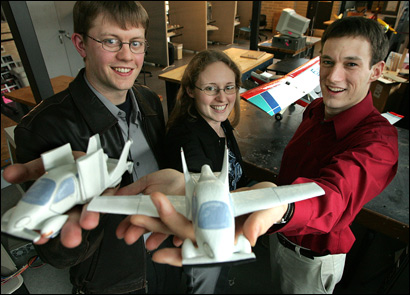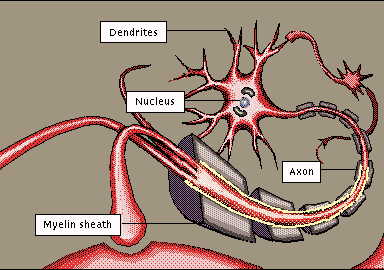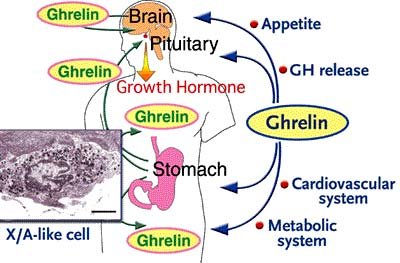IEEE Spectrum Reports on Cyborg Psychiatry
 The March online issue of IEEE Spectrum reports on the use of electromagnetic technology in Psychiatry. It is a 4-page report, with a better technological slant than the NYT article discussed in the previous Cyborg posting.
The March online issue of IEEE Spectrum reports on the use of electromagnetic technology in Psychiatry. It is a 4-page report, with a better technological slant than the NYT article discussed in the previous Cyborg posting.The technology McGuffee uses, vagus nerve stimulation, was the first to enter routine clinical use. A pacemakerlike device about the size of a pocket watch, implanted under the skin of the chest, pulses a nerve in the neck [see illustration, "Vagus Nerve Stimulation"]. In about 16 percent of patients like McGuffee, according to clinical studies, that electric pulsing completely quashes the symptoms of depression. It was approved as a depression therapy, for use in conjunction with drugs, by government regulators in the European Union and Canada in 2001. Last June, it became the first psychiatric device to be reviewed and approved in the United States, which has more stringent requirements for medical devices. Nevertheless, a number of psychiatrists remain unconvinced that the therapy works in enough people to outweigh the risk and cost of surgery.
Vagus nerve stimulation isn't the only technology being touted for treatment of the severely depressed. Another technique, repetitive transcranial magnetic stimulation, uses powerful magnets to generate current in well-defined portions of the brain [see illustration, "Repetitive Transcranial Magnetic Stimulation"]. Many research groups around the world have experimented with the technology. At last count the results of more than 60 depression trials performed in Australia, Israel, Taiwan, the United States, Europe, and elsewhere had been published. But clinical use is just beginning. The technology is winding its way toward a review by U.S. regulators, and the company behind it, Neuronetics Inc., in Malvern, Pa., says it could be approved within the year.
And these two are just the ones closest to the clinic. Researchers are exploring three other, more experimental technologies. One uses direct current to produce a change in the brain similar to that of magnetic stimulation. Another uses transcranial magnetic stimulators to spark seizures just as electroconvulsive therapy does but, it is hoped, without the amnesia that can accompany it. The third experimental technology borrows a device used to control the tremors of Parkinson's disease. Surgeons have begun implanting electrodes in patients' brains to switch off malfunctioning brain circuits involved in depression and obsessive-compulsive disorder.
Read the whole thing here. Here is more from IEEE:
After one year, one in six patients treated with the nerve stimulator was free of depression, and 56 percent got some meaningful benefit—as measured by a standardized questionnaire used to rate the severity of a patient's depression. Of those who did respond, about 70 percent continued to benefit after two years. But waiting a year to see if the treatment worked in a disease that comes at irregular intervals was highly unusual. The lack of a control group that had the device implanted but not turned on to counteract the placebo effect was stranger still. In August 2004, the U.S. Food and Drug Administration, which regulates the marketing of medical devices, decided not to allow Cyberonics to sell the vagus nerve stimulator as a depression treatment, overruling its own advisors in the process.
.... Deep-brain stimulation has been in use for years to treat the tremors of Parkinson's disease. In that case, 3- to 5-volt pulses at about 100 Hz are applied to a part of a brain circuit that malfunctions and causes the tremors. The stimulation suppresses the activity of neurons near the electrode, mimicking their surgical destruction, but with a key twist. "Basically, it's reversible and tunable brain surgery," says Schlaepfer. Turn the device on, and that section of the brain goes off-line. Turn it off, and the neurons spring back into action. It's a simplistic view, of course, and scientists still don't know if the electrode's current blocks brain traffic by holding the cells at too high a voltage to propagate a signal, exhausts their supply of chemical transmitters, overlays a meaningless jamming signal on them, or does something different entirely.
The device has also been used to treat severe obsessive-compulsive disorder; indeed, this was its first use in psychiatry. In that treatment, neurosurgeons had been destroying a few cubic millimeters of a particular structure in the brain. Now surgeons have begun inserting electrodes instead of destroying those tiny parts of the brain.
A group based at the University of Toronto and led by neurosurgeon Andres Lozano and neurologist Helen S. Mayberg reported the first trial of deep-brain stimulation for depression only a year ago. (Mayberg has since become a professor at Emory University, in Atlanta.) Imaging studies led them to Broadmann area 25, a pair of structures deep in the brain just above and behind the eyes that become active when people are sad. It has abnormally high blood flow in people with treatment-resistant depression; antidepressant drugs tend to reduce the amount of blood flow there. So the Toronto researchers implanted electrodes powered by a Medtronic stimulator in that spot in six patients. Five of the six responded well initially, and four continued to do so six months out. According to Lozano, those four are still doing well two years later. Lozano, who has been implanting deep-brain stimulators for more than a decade, says that not enough is known about why patients respond or don't respond to the procedure to say if there is a need to tweak the technology. "We don't know if it's the electrodes or the patients," he says.
Although the seminal work was done using stimulators made by Medtronic, another maker of implantable stimulators, Advanced Neuromodulation Systems Inc. (ANS), in Plano, Texas, holds the relevant intellectual property rights, according to Rohan Hoare, the company's vice president of corporate strategy and development. ANS is now replicating Mayberg and Lozano's results in a pilot study using its Libra deep brain stimulation system. The main difference between the Medtronic systems used in Toronto and Bonn and ANS's devices is that Medtronic's delivers a constant-voltage pulse, which allows the current to vary depending on the impedance of the brain, while its competitor delivers constant current, allowing the voltage to vary. ANS's vice president for scientific affairs, Tracy Cameron, notes that most animal research has been done using constant-current stimulators and hypothesizes that this approach may be more in tune with the brain's physiology.
Labels: cyborgs, electromagnetic brain stimulators




































